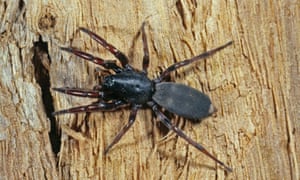'Spider bite' double amputation likely to be mistaken identity, experts say
 |
| Media outlets reported both legs were amputated because of the progression of ‘flesh-eating bacteria’ induced by a white-tail spider bite. Photograph: Jeff Wright/Queensland Museum |
White-tail spider unlikely to be responsible for necrotising skin infection that led to amputation of Filipino tourist’s legs
=====
A Melbourne man’s double amputation is likely to have been misattributed to a white-tail spider bite.
The family of Terry Pareja, a Filipino tourist, say he may have been bitten by a white-tailed spider while visiting relatives in Birchip in regional Victoria in late February.
He underwent emergency surgery at Wimmera Base hospital in Horsham, Victoria, to have his right leg amputated on 27 February. He was then airlifted to the Alfred hospital in Melbourne the following morning, where his left leg was amputated.
Pareja’s case had not been widely known until Wednesday, when Fairfax Media reported that the double amputation was necessary owing to the progression of “flesh-eating bacteria” induced by a white-tail spider bite.
His brother-in-law, Ray Ogleby, told 3AW on Wednesday that a toxicology report pointed to a “possible spider bite”.
Two species of white-tail are common in southern and eastern Australia. Their venom is widely purported to cause ulceration and necrotic lesions for which there is no treatment but there is no evidence to support this.
A cohort study published in August 2003 investigated 130 cases of confirmed white-tail spider bites between February 1999 and April 2002 and found that none had resulted in necrotic lesions.
“This provides good evidence that necrotic ulcers are unlikely to be a result of white-tail spider bite, and previously reported cases are more likely a result of misattribution,” concluded the authors, Geoffrey Isbister and Michael Gray.
The venom had “little potential” to cause necrosis, the researchers found, pointing to another study that had concluded it had “little effect on human cell cultures”.
Isbister, a researcher at the University of Newcastle, told Australian Associated Press on Wednesday that cases were often misattributed to spiders in the absence of a clear, alternative diagnosis.
“It’s all about people wanting to be able to label what they have – much better that a spider did this, rather than ‘we are not sure’,” he said.
The reporting of Pareja’s case proved the link between necrosis and white-tail spider bites persisted, even though, as the Queensland Museum arachnologist Robert Raven pointed out to Guardian Australia, “the refutation is now over 10 years old”.
“It’s really quite disturbing to see that this stuff has been reborn,” he said, adding: “For a long time, even at the height of the issue, we said, this is not the spider that’s doing the damage.”
A spokeswoman for Wimmera Base hospital told Guardian Australia that Pareja had undergone an amputation there for a “necrotising skin infection”. A spokeswoman for the Alfred hospital said he was in a serious but stable condition but would not comment on the diagnosis.
Pareja’s daughter has launched a crowdfunding campaign to cover her father’s medical costs.
“An insect bit him but he really wasn’t aware, not until he felt uneasy,” she wrote. “Few hours later, his foot began to hurt and then swell eventually …
“Doctors think it was a white-tailed spider that bit him.”
According to his daughter, Pareja could face double amputation of both arms.
In many cases of bites attributed to white-tail spiders the patient did not see a spider nor feel a bite, Raven said.
“This is the problem with a lot of these cases: what we get is: ‘Did you see the spider?’ ‘No.’ ‘Did you feel it bite?’ ‘No.’ ‘Then how did you know you were bitten?’ ‘Because a doctor told me.’”
There was, in fact, no way for doctors to diagnose bites from any species of spider other than redbacks and funnel-webs, he said.
A 2004 study had found that 11 cases of necrotic ulcers misattributed to white-tail spider bites between January 2000 and June 2002 “were found to have alternative diagnoses with appropriate investigations”. There was a range of final diagnoses, including an infected diabetic ulcer, a staphylococcal abscess and various skin infections such as tinea.
Not only did no species of Australian spider have necrotic venom, said Raven, white-tail spiders’ mouths were too small to penetrate human skin.
“The thing we’ve said over and over again is that spiders don’t have necrotic venom. You imagine what it is: a spider bites you, and it’s going to follow you until you die? No. It needs to bring the animal down quickly.”
Raven said on the ABC just last week the reported impact of whitetail spiders was a “total furphy”, attributing the persistence of the misinformation as a case of “let’s not let the truth get in the way of a good story”.
“The litany of things that were attributed to white-tail spiders was absolutely horrendous.”
Tidak ada komentar:
Posting Komentar